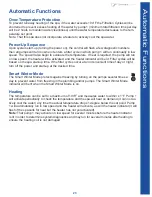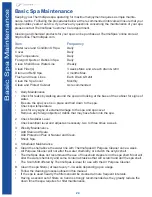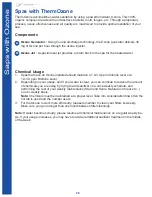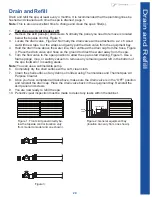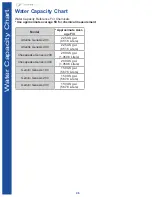
37
Copper
- Copper in water is a common problem in many households. Copper is present due to
the corrosion of plumbing materials from Acidic (low pH) or Aggressive water (low TDS). Com-
mon problems associated with copper due corrosion are leaks in the plumbing system or blue-
green staining. High copper content can also cause some health concerns by effecting the stom-
ach and intestines. The EPA has set a maximum contaminant level of 1.3 ppm.
Disinfect
- To kill living organisms on contact. The difference between a disinfectant and a sani-
tizer is the “kill time”: a disinfectant kills 99.9% of living organisms instantly. Chlorine and bromine
are the only two sanitizers classified as disinfectants.
Enzymes
- Used in spa formulations designed to break down and digest oils similar to the way
enzymes are used in oil spill clean-up efforts.
Fill Water
- Used in filling or adding to the water level. Whether from the hose or from a well,
your fill water brings its own chemical make up and water balance (or lack thereof).
Filter
- A device used to remove particles suspended in the water by pumping water through a
porous substance or material.
Filter Cleaner
- A deep cleaning filter soak that includes a releasing agent to relax the filter me-
dia and allow dirt and grim to be dissolved and cleaned.
Filter Media
- A pleated, porous synthetic fabric in filter cartridges, used to trap foreign matter.
Filter cartridges must be cleaned regularly with filter cleaning compounds.
Foam Away
- Excessive foaming is typically caused by swim wear used when bathing in a spa.
Using a capful of “Foam Away” instantly reduces foam and will allow detergents to be filtered out
of your water.
Foaming
- A term used to describe surface foam on your water, especially in spas/hot tubs.
Foaming is caused by high TDS levels working in combination with soft water and oils. Certain
low grade algaecides can foam when added to the spa. Use enzymes for foam control.
Iron
- An element often found discolored in ground water (in the form of ferrous iron) in concen-
trations usually ranging from zero to 10 ppm (mg/1). It is objectionable in water supplies because
it can effect water taste and cause unsightly colors produced when iron reacts with tannins in
beverages such as coffee and tea. Iron causes staining after oxidation and precipitation, as ferric
hydroxide (yellow, brown, and red on clothing, dishes, fixtures, and bathroom tile). Iron can also
be found in a bacterial form which will appear as black or brown slime and can effect the odor of
your water. Iron is a common water problem throughout the United States, it can be found in well
water and municipal water. The EPA has set a maximum level for Iron of 0.3 ppm in water, iron
concentrations at this level or higher can cause staining.
Jet Line Cleaner
- This anti-bacterial cleaner is added to spa water prior to draining and refill-
ing. Left in the spa for an extended period (3 – 24 hrs), this cleaner will break down accumulated
biofilm in spa plumbing. This product can also be used in jetted bath tubs.
Manganese
- An element sometimes found in ground water, usually with dissolved iron but in
lower concentrations. Manganese is a typical natural occurring mineral found in municipal and
well water. Manganese effects the taste and the color or water. Manganese can also cause stain-
ing of clothes and dish ware and black stains and other problems similar to iron. The EPA has
determined that concentrations greater than 0.05 ppm can cause these aesthetic problems.
Glossary
Summary of Contents for Atlantis Genesis 200
Page 1: ...ThermoSpas Genesis Series Owner s Manual Safety Maintenance and Technical Information...
Page 5: ...Spa Measurements Chart 45 Water Capacity Chart 46...
Page 6: ......
Page 53: ......
Page 54: ......
Page 55: ......

